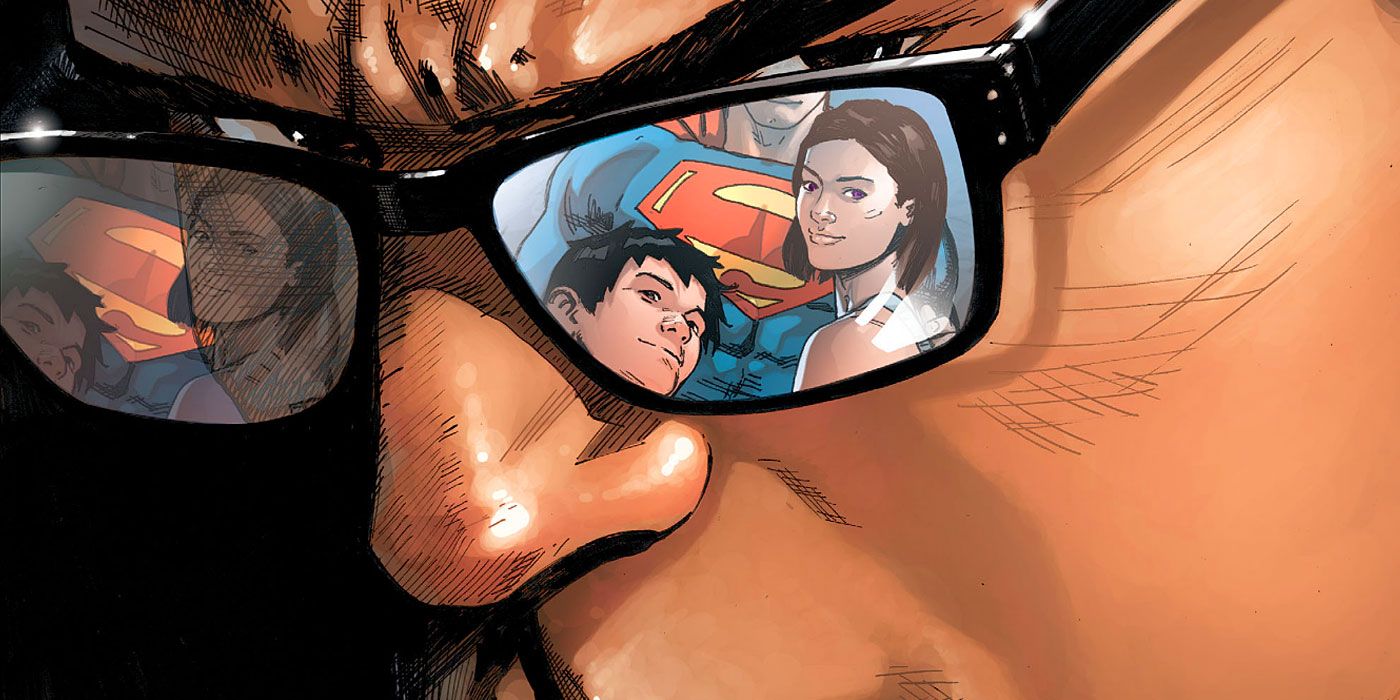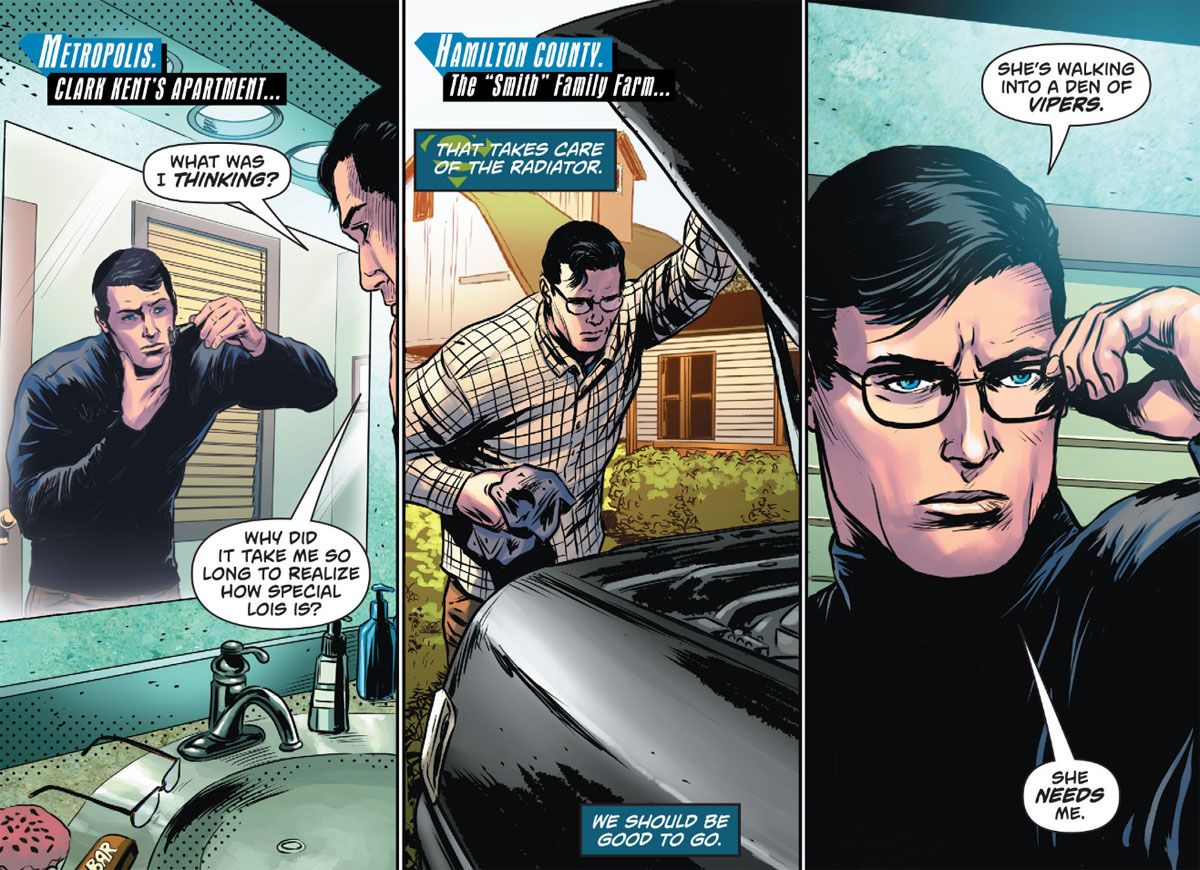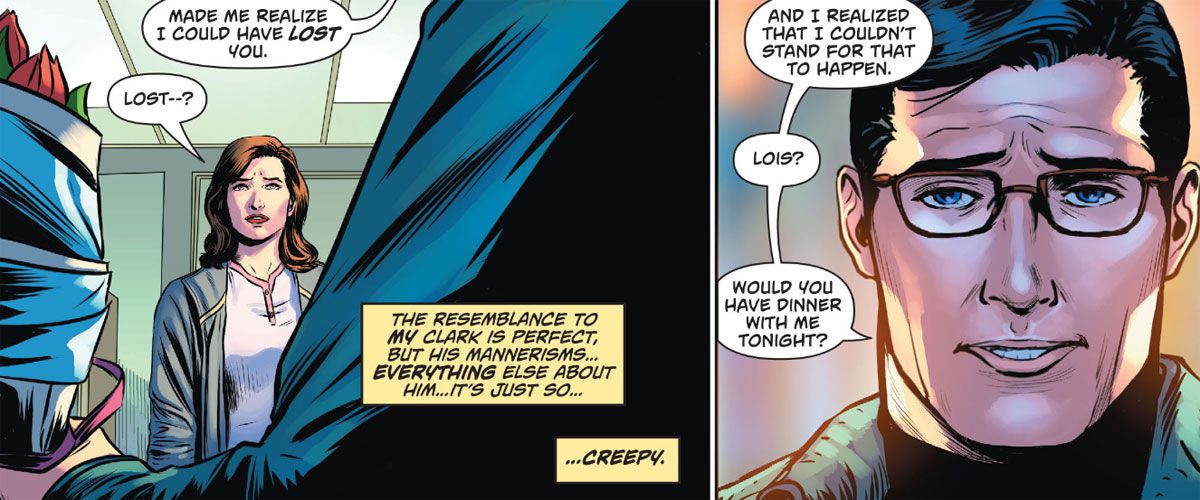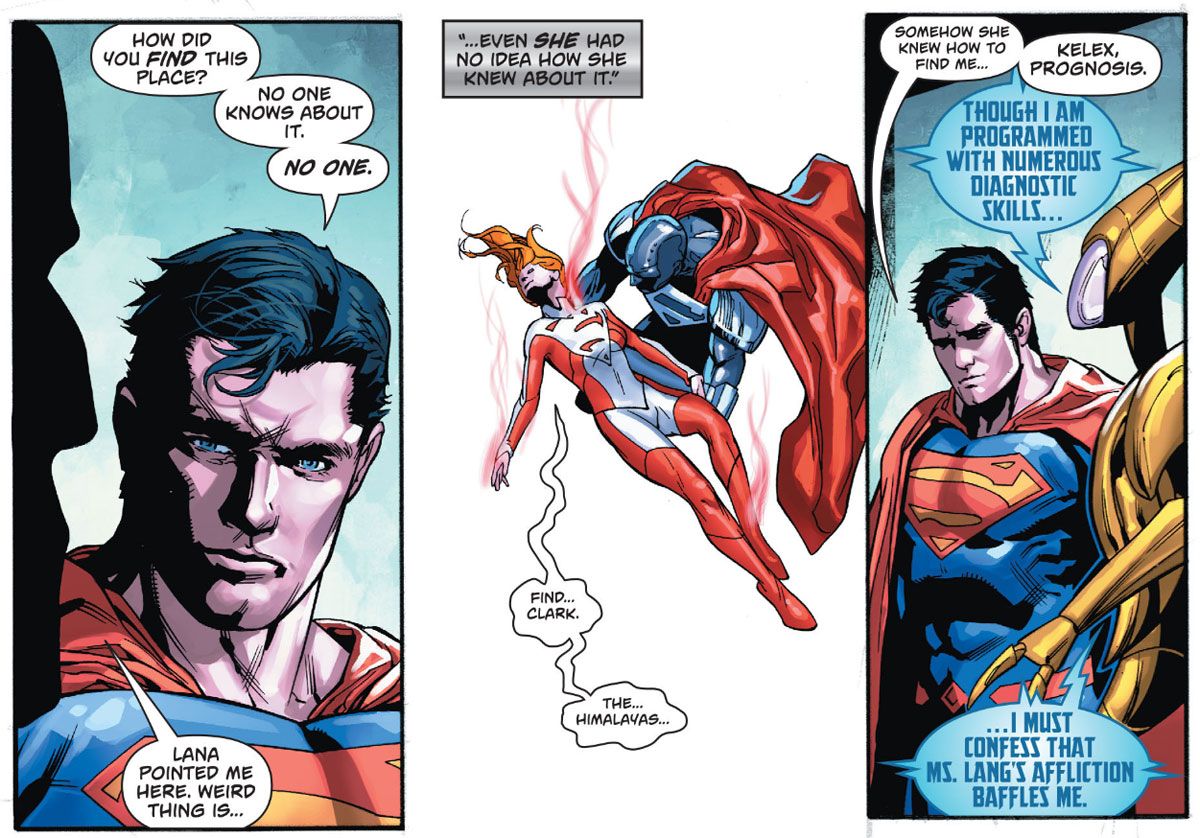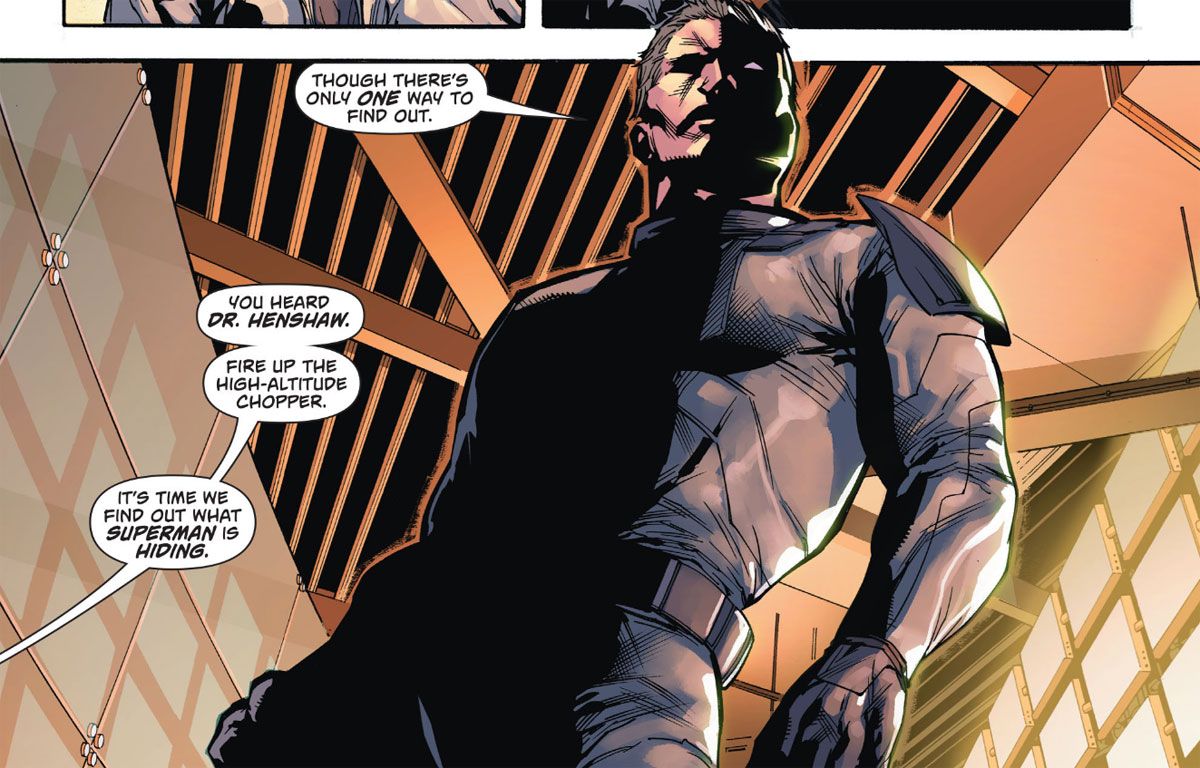SPOILER WARNING: This issue contains spoilers for "Action Comics" #973, on sale now.
The mystery of the all-too-human Clark Kent takes center stage in "Action Comics" #973, the first installment of the "Mild Mannered" story arc by Dan Jurgens, Patrick Zircher and Stephen Segovia. Superman's post-"Rebirth" world could be modeled on Shakespeare's "Comedy of Errors" for all the alternate-universe doppelgangers and identity switcheroos, but even as the pre-"Flashpoint" Man of Steel and Lois Lane assume the roles of their deceased New 52 versions, the Clark Kent who arrived in Metropolis after the demise of this universe's Superman has been an enigma. This week's issue does not provide many answers, but raises some intriguing questions.
Disguised as Clark Kent
Throughout Jurgens' arc, Clark has been largely portrayed as the earnest, often bumbling weakling Siegel and Shuster originally intended for Superman's alter ego -- a good man whose contrast with Metropolis's hero could not be greater. No one would suspect that mild-mannered is secretly Superman, and indeed, it would seem that this Clark is not. He also does not appear to know who Superman really is, or Lois's connection to him.
The most interesting question raised this issue, though, is does Clark know who -- or what -- he is?
The issue begins with Clark in his Metropolis apartment, pondering his feelings for Lois, with the narrative cutting between him and a different Clark, our Superman, currently living on a farm. Clark's behavior appears normal, if a bit dopey.
He soon insinuates himself into an undercover operation Lois is running with Maggie Sawyer of the Metropolis Special Crimes Unit. Afterward, a suspicious Lois follows Clark as he orders a ridiculous amount of calories from Big Belly Burger and walks back to his apartment building, observing that "it's pouring, yet he seems not to notice the rain."
But when Lois enters the apartment building -- the same one her Clark lived in before they were married -- Clark is nowhere to be found, and the doorman says that he hasn't seen Clark Kent in months.
The next day, back at the Daily Planet, Clark takes the very professional step of buying Lois flowers and asking her to dinner. Lois at first says no, but then realizes "this man who shouldn't exist… has given me an exclusive." Good work, Ace!
So, what do we learn about Clark this issue?
- He lives in, or seems to believe he lives in, Clark Kent's apartment. It's where he brushes his teeth in the morning, and where he returns to eat fast food alone. Yet the doorman has never seen him enter.
- He isn't bothered by rain. #1 and #2 might suggest that he's only partially real, or that only certain people can perceive him, yet he regularly physically interacts with other people and objects, including tripping over a bunch of stuff during Lois' undercover op.
- Like every other version of Clark Kent, he's in love with Lois.
- His penchant for old-timey words like "hoosegow" is enough to draw suspicion.
- Lois finds him creepy. This is not something that's been especially well conveyed up until now, and does potentially color how readers interpret his actions.
Curiouser and curiouser...
Why is Superwoman in this story?
While Lois investigates Clark, Superman checks out an alarm at his Fortress of Solitude, where he finds Steel and the debilitated Superwoman, aka Lana Lang. Lana's sickness since gaining her powers is an ongoing plotline in the "Superwoman" series, so it makes sense that she would seek out Kal-El's aid.
But another aspect of Lana's sickness is seeing visions of the New 52 Lois Lane, who also gained powers when N52 Superman died, but who perished on her first mission as Superwoman. Although Lana interprets her conversations with Lois as hallucinations, recently it has come to light that certain other beings can see her. Does Lana's appearance here suggest that phantom Lois and doppel-Clark are connected?
Add to the mix that Lana was able to home in on the Fortress despite the fact that, according to Supes, "no one knows about it."
A storyline you may have missed
Before "Rebirth," Jurgens wrote an eight-issue miniseries called "Superman: Lois and Clark," which saw the pre-"Flashpoint" Superman and Lois, along with their son Jon, hiding out on the New 52 Earth following the events of "Convergence." Operating in the shadows -- with a beard and black super-suit -- the once and future Superman took advantage of his position on a slightly younger Earth to stop potential threats before they got out of hand. Lois slowed the rise of Intergang through her investigative reporting, while Clark investigated the disaster that, on his Earth, created one of his greatest foes, the Cyborg Superman.
Created by Jurgens, Hank Henshaw debuted in 1990's "Adventures of Superman" #466, in a story that might as well have been called "What if the cosmic rays that gave the Fantastic Four their powers also killed them horribly?" After watching his friends die gruesome deaths, Henshaw himself appeared to succumb. Later, after Superman's death at the hands of Doomsday, a gruesome man of metal arrived to fill the void, convincing Metropolis through word and deed that he was Superman returned to life. But surprise! This turned out to be a very insane Hank Henshaw, who had gained mastery over all machines and used Kal-El's birth pod to create some clever DNA grafts. He blew up Coast City, driving Hal Jordan mad. (Both got better.)
So, naturally, when Henshaw's shuttle again crashes to Earth in the "Lois and Clark" mini, Superman wants to investigate. This time, though, Henshaw is alone in the shuttle and appears unharmed, though he has no memory of his ordeal. He is also in possession of an artifact called the Oblivion Stone, which possesses some mystical properties and is coveted by alien warriors. Kal-El ultimately concedes that this man will not become the Cyborg Superman, but still needs to be kept under close watch.
Also, post-"Flashpoint," Supergirl's dad Zor-El is the Cyborg Superman instead. Kara is currently fighting to stop him replacing humans with cybernetically reanimated Kryptonians.
Henshaw re-appears this issue in a final-page reveal, tracking Superman and Steel as they seek help for Lana Lang.
While in the Fortress, Superman reminds us that he's been keeping a telepath prisoner since the events of "Lois and Clark," the new '90s-esque villain Blanque.
Pieces of the Puzzle
All of this taken together would suggest that the new Clark Kent is somehow a manifestation of the Oblivion Stone, possibly under the direction of Blanque or Henshaw, and is intrinsically tied to Superwoman's fate. But this is not necessarily the case.
Beginning with "Lois and Clark" and continuing on through "Action," Jurgens has been turning in his best work in years -- but it's important to remember his perspective, where he comes from creatively. Comics' push toward discreet story arcs that can be collected into bookshelf volumes, coupled with rapid changes in creative teams, has broadly led to storylines that are neatly wrapped up in a fairly short period of time -- there are "season arcs," of course, and events seeded early that pay off later, but, broadly, these are the exception rather than the rule, and often play out more gradually (see: the X-Men's Cyclops' evolution from mutant leader to revolutionary, etc.). In the '90s, though, writers were dropping seeds left and right -- Chris Claremont, notoriously, planted an entire field he never got around to watering. This is the environment Jurgens comes from, where he knew he could play the long game; he wrote Superman for ten years straight, encompassing the whole of that fabulous decade. And there was no thought given to focusing a story for the trade paperback -- the "Death of Superman" volume contains stuff about a character named Bloodwynd that you'd really have to hunt down back issues of "Justice League America" to sort out if you're interested. Given that Jurgens' current work bears many of the hallmarks of his earlier run -- villains with 'q' in their names, Intergang, an increased focus on the supporting cast -- there's little reason to think his mindset has changed regarding how to structure a story.
The mystery of Clark Kent was a solid B-plot graduating to A-plot in the "Mild Mannered" arc; the question becomes, then, how much of what we see in this issue relates to the current story, and how much is setting up other events? If we assume that the whole burden of the detective work isn't going to be on Lois, then at least one of Superman's actions this issue should point toward the resolution. And it would be in keeping with Jurgens' style for the events of "Lois and Clark" to reverberate at this particular juncture.
Or perhaps the answer is more subtle, and will draw on the talents of another classic villain. After all, doesn't a false Clark Kent seem just like something Mxyzptlk would come up with?

